List of Mississippian sites
Main article: Mississippian culture
This is a list of Mississippian sites. The Mississippian culture was a mound-building Native American culture that flourished in what is now the Midwestern, Eastern, and Southeastern United States from approximately 800 CE to 1500 CE, varying regionally.[1]
| Site | Image | Description |
|---|---|---|
| Adams Site | Located near Hickman in Fulton County, Kentucky, it consists of a 7.25 hectare village area built over the remains of a Late Woodland village with a central group of platform mounds around a central plaza and another smaller plaza area to the southwest of the largest mound, occupied during the Medley(1100 to 1300) and Jackson(1300 to 1500) Phases of the local chronology.[2] | |
| Adamson Mounds Site | Located near Camden, Kershaw County, South Carolina. It is a prehistoric Native American village site containing one large platform mound, a smaller mound, possibly a third still smaller mound, and a burial area. Lamar, Irene, or Pee Dee and dates between 1400 and 1700.[3] | |
| Angel Mounds | 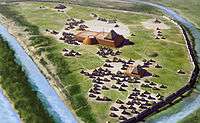 |
A chiefdom in southern Indiana near Evansville. |
| Ashworth Archaeological Site |  |
An archaeological site of the Caborn-Welborn variant of the Mississippian culture. |
| Avery Site | A multimound and village site, now destroyed, located in Troup County, Georgia east of the Chattahoochee River.[4] | |
| Aztalan State Park |  |
A small Mississippian chiefdom in Wisconsin, the northern edge of the greater Mississippian culture |
| Battle Mound Site | Located in Lafayette County, Arkansas in the Great Bend region of the Red River basin and has the largest mound of the Caddoan Mississippian culture | |
| Beasley Mounds Site | Also known as the Dixon Springs Mound Site, located at the confluence of Dixon Creek and the Cumberland River near the unincorporated community of Dixon Springs in Smith County, Tennessee. More examples of Mississippian stone statuary have been found at the site than any other in the Middle Tennessee area.[5] | |
| Beaverdam Creek Archaeological Site | A single mound and village site now inundated by the Richard B. Russell Reservoir in Elbert County, Georgia approximately 0.8 km from the creek's confluence with the Savannah River. Abandoned sometime after 1300 CE.[6] | |
| Belcher Mound Site | A Caddoan site located in Caddo Parish, Louisiana[7] in the Red River Valley 20 miles north of Shreveport[8] and about one-half mile east of the town of Belcher, Louisiana[9] | |
| Bell Field Mound Site | A South Appalachian Mississippian single mound site located on the western bank of the Coosawattee River below the Coosawatee’s junction with Talking Rock Creek. The site, along with the Sixtoe Mound and Little Egypt site were destroyed by the construction of Carters Dam in the 1970s.[10] | |
| Boyd Mounds Site | 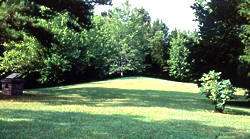 |
A site from the Late Woodland and later Mississippian culture located in Madison County, Mississippi near Ridgeland. It is located at mile 106.9 on the old Natchez Trace, now the Natchez Trace Parkway.[11] |
| Brentwood Library Site | Also known as the Jarman Farm Site, it is a village and associated burial area located in Brentwood, Tennessee. It was occupied during the Thurston Phase of the local chronology and artifacts from the site have been radiocarbon dated to 1298 to 1465 CE.[12] | |
| Brick Church Mound and Village Site | A multi-mound palisaded village site located in Nashville in Davidson County, Tennessee[13] | |
| Bussell Island | An island at the mouth of the Little Tennessee River in Loudon County, Tennessee, believed to have been the location "Coste," visited by de Soto in 1540 | |
| Caddoan Mounds State Historic Site | Also known as the George C. Davis Site (41CE19), a Caddoan Mississippian site located in Cherokee County, Texas 26 miles west of Nacogdoches, Texas on Texas State Highway 21 near its intersection with U.S. Route 69 in the Piney Woods region of east Texas | |
| Cahokia |  |
Near East St. Louis, Illinois, Cahokia was possibly the first, and certainly the largest and most influential of the Mississippian mound centers. |
| Campbell Archeological Site |  |
The Campbell Archeological Site ( 23 PM 5), is a site in Southeastern Missouri occupied by the Late Mississippian Period Nodena Phase from 1350 to 1541 CE. |
| Castalian Springs Mound Site |  |
In Castalian Springs, Tennessee, the site was once home to a substantial Mississippian-period (1000-1400 CE) village with 12 known mounds at the site. |
| Chauga Mound | A South Appalachian Mississippian single mound and village site located on the northern bank of the Tugaloo River 1,200 feet (370 m) north of the mouth of the Chauga River in Oconee County, South Carolina now inundated by Lake Hartwell.[14] | |
| Chucalissa Indian Village |  |
The site is a Walls Phase Mississippian site dating back to the 15th century, located in the city of Memphis in West Tennessee and was occupied, abandoned and reoccupied several times throughout its history, spanning from 1000 to 1550 CE. |
| Citico (Hamilton County, Tennessee) | In the Coosa confederacy, the site of a large Mississippian mound dating back to the 15th century, located in the city of Chattanooga on Citico Creek. The town was occupied, abandoned and reoccupied several times throughout its history, spanning from 1000 (Muscogee) to 1778 (Cherokee) ce. | |
| Cloverdale archaeological site | An important archaeological site near St. Joseph, Missouri. It is located at the mouth of a small valley that opens into the Missouri River. It was occupied by Kansas City Hopewell (ca. 100 to 500 CE) peoples and later by Mississippian influenced Steed-Kisker peoples(ca. 1200 CE). Because of the many Cahokia style projectile points found at the site, it is believed to have been a trade partner or outpost of the much larger Cahokia polity.[15] | |
| Dickson Mounds | 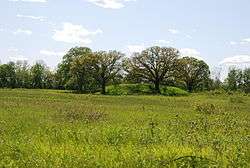 |
A settlement site and burial mound complex near Lewistown, Illinois in Fulton County on a low bluff overlooking the Illinois River. The site is named in honor of chiropractor Don Dickson, who began excavating it in 1927 and opened a private museum that formerly operated on the site.[16] |
| Dyar site | A single mound and village site located in Greene County, Georgia inhabited almost continuously from 1100 to 1600 CE and now submerged under Lake Oconee.[17] | |
| Eaker Site |  |
The site is the largest and most intact Late Mississippian Nodena Phase village site within the Central Mississippi Valley.[18] |
| Emerald Mound and Village Site |  |
A Middle Mississippian period archaeological site located near Lebanon, Illinois. The platform mound is the second-largest Pre-Columbian earthwork in Illinois, after Monk's Mound at Cahokia. |
| Emerald Mound Site |  |
A Plaquemine Mississippian period archaeological site located on the Natchez Trace Parkway near Stanton, Mississippi. The site dates from the period between 1200 and 1730 CE. The platform mound is the second-largest Pre-Columbian earthwork in the country, after Monk's Mound at Cahokia |
| Emmons Cemetery Site | A Middle Mississippian culture site located in Kerton Township, Fulton County, Illinois, on the edge of a bluff overlooking the Illinois River to its east. The location was a used as a cemetery and several unique and rare items were found interred with the burials.[19] The burials were in several small burial mounds located on the lower slope. The cemetery area measures about 50 feet (15 m) square.[20] | |
| Etowah Indian Mounds | 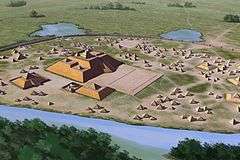 |
One of the major Mississippian chiefdoms, belonging to the South Appalachian Mississippian culture, located in Georgia, believed by some to be a long-standing antagonist of the Moundville polity. |
| Fewkes Group Archaeological Site | |
Located in the city of Brentwood, in Williamson County, Tennessee. The 15-acre site consists of the remains of a Late Mississippian culture mound complex and village roughly dating to 1050-1475 CE.[21] The site, which sits on the western bank of the Little Harpeth River, has five mounds, some used for burials and others, including the largest, were ceremonial platform mounds.[22] |
| Fort Walton Mound |  |
The Fort Walton Mound was built about 1300 CE by Fort Walton Culture. Located in Fort Walton Beach, Florida, near the intersection of State Road 85 and U.S. Route 98, in the Florida Panhandle. |
| Garden Creek site | Two Pisgah Phase villages, occupied from 600–1200 CE, and three mounds (31Hw1-3) in Haywood County, North Carolina | |
| Grand Village of the Natchez | 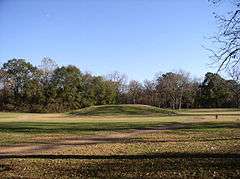 |
The main village of the Natchez people, with three mounds. A Plaquemine Mississippian period archaeological site used and maintained into historic times |
| Holly Bluff Site |  |
Type site for the Lake George phase of the Plaquemine culture, on the southern margin of the Mississippian cultural advance down the Mississippi River and on the northern edge of the Cole's Creek and Plaquemine cultures of the South |
| Hoojah Branch Site | A South Appalachian Mississippian single mound and village site located in Rabun County, Georgia about one mile east of Dillard, Georgia in the Chattahoochee National Forest. | |
| Hovey Lake-Klein Archeological Site |  |
A Caborn-Welborn site, located on the west bank of Hovey Lake, a backwater lake near the Ohio River close to its confluence with the Wabash River. The site was an extensive village occupation dating between 1400-1650 CE. |
| Jaketown Site | 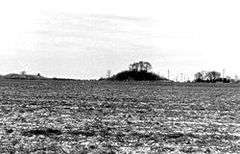 |
A site with two in Humphreys County, Mississippi dating from roughly 1100 CE to 1500 CE, located along Mississippi Highway 7 approximately seven miles north of Belzoni. The largest platform mound at the site, Mound B, is 23 feet (7.0 m) in height with a base of 150 feet (46 m) by 200 feet (61 m). It has a projection on its eastern side that is thought to have been a ramp once used as a stairway. To its northeast is Mound C, another platform mound with a height of 15 feet (4.6 m).[23] |
| Jere Shine Site | A South Appalachian Mississippian culture multimound and village site located near the confluence of the Tallapoosa and Coosa rivers in modern Montgomery County, Alabama and likely occupied from 1400–1550 CE. In addition to its Mississippian-era Shine I-phase, it is the largest settlement associated with the Shine II-phase of the lower Tallapoosa River.[24] | |
| Joara |  |
The largest chiefdom in North Carolina at contact; also possibly the furthest northeastern Mississippian chiefdom center, near Morganton |
| Joe Bell Site |  |
A village site occupied during the local Duvall Phase and Bell Phases of the South Appalachian Mississippian period and located south of the mouth of the Apalachee River on the western bank of the Oconee River and now submerged under Lake Oconee.[25] |
| Jordan Mounds | 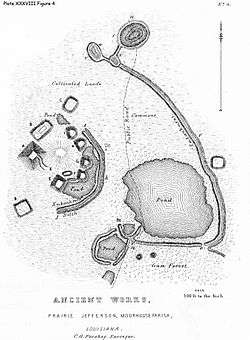 |
A multi-mound site (16 MO 1) in Morehouse Parish, Louisiana near Oak Ridge, Louisiana.[26] The site was constructed during the protohistoric period between 1540 and 1685.[27] |
| Kincaid Mounds State Historic Site | 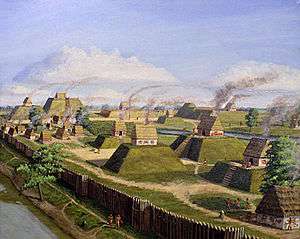 |
A major Mississippian mound center in southern Illinois across the Ohio River from Paducah, Kentucky |
| King Archaeological Site | A 5 acres (0.020 km2) Lamar Phase village located on the eastern bank of Coosa River in Hardin County, Tennessee. The site was a satellite village associated with the Coosa chiefdom.[28] | |
| Lamar Mounds and Village Site | Type site for the Lamar Phase, located on the banks of the Ocmulgee River in Bibb County, Georgia and several miles to the southeast of the Ocmulgee Mound Site. Both mound sites are part of the Ocmulgee National Monument, a national park and historic district created in 1936 and run by the National Park Service.[29] Historians and archaeologists have theorized that the site may be the location of the main village of the Ichisi encountered by the Hernando de Soto expedition in 1539.[30] | |
| Letchworth Mounds |  |
A Fort Walton Culture Florida State Park located approximately six miles west of Monticello, a half mile south of U.S. 90, in northwestern Florida. It contains the state's tallest ceremonial mound (46 feet), estimated to have been built 1100 to 1800 years ago. |
| Lake Jackson Mounds Archaeological State Park |  |
The site is one of the most important sites in Florida, a former chiefdom and ceremonial center of the Fort Walton Culture. The complex originally included six mounds, a constructed plaza and numerous individual village residences. Located in the Florida Panhandle, it is in northern Tallahassee, on the south shore of Lake Jackson. |
| Liddell Archeological Site | |
Located in Wilcox County, Alabama, it covers 50 acres (20 ha) and shows evidence of human occupation from 9000 BCE to 1800 CE. It is best known for its Mississippian artifacts from the Burial Urn Culture period. The Liddell, Stroud, and Hall families donated the site to Auburn University after its discovery.[31] |
| Little Egypt site | Located in Murray County, Georgia, near the junction of the Coosawattee River and Talking Rock Creek. It was destroyed during the construction of the Dam of Carters Lake in 1972. It was situated between the Ridge and Valley and Piedmont sections of the state in a flood plain.[32] | |
| Long Swamp Site | Located in Cherokee County, Georgia on the north shore of the Etowah River near St Rt 372. The site consists of a South Appalachian Mississippian village with a palisade and a platform mound.[33] | |
| Mandeville Site | A multimound and village site located in Clay County, Georgia and now submerged under Walter F. George Lake, which is a part of the Chattahoochee River basin. Occupied during the Middle Woodland period by Early Swift Creek culture and later by peoples of the South Appalachian Mississippian culture.[34] | |
| Mangum Mound Site | |
A Plaquemine site in Claiborne County, Mississippi, located at milepost 45.7 on the Natchez Trace Parkway. An avian themed repoussé Mississippian copper plates was discovered there in 1936.[35] |
| Marshall Site | An Early Mississippian site located near Bardwell in Carlisle County, Kentucky, on a bluff spur overlooking the Mississippi River floodplain. It was occupied from about 900 to about 1300 CE during the James Bayou Phase of the local chronology and abandoned sometime during the succeeding Dorena Phase.[36] A large village site with evidence of once having had platform mound and earthworks.[37] | |
| Menard-Hodges Site | In Arkansas, it includes two large mounds as well as several house mounds, possibly the Province of Anilco encountered by the Hernando de Soto Entrada in 1540.[38] | |
| Mitchell Archaeological Site | A site in Davison County, South Dakota, near Mitchell, South Dakota. Mitchell Site is the only reliably dated site (c. 1000) pertaining to the Lower James River Phase (Initial Variant) of the migration of late Mississippian culture to the Middle Missouri Valley. It is distinctive for its evidence relating mortuary practices to other intra-site practices. | |
| Mound Bottom |  |
The complex in Cheatham County, Tennessee consists of ceremonial and burial mounds, a central plaza, and habitation areas, built between 950 and 1300 CE |
| Moundville Archaeological Site | 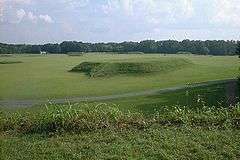 |
Ranked with Cahokia as one of the two most important sites at the core of the classic Mississippian culture,[39] located near Tuscaloosa, Alabama. |
| Murphy Mound Archeological Site |  |
The Murphy Mound Archeological Site ( 23-PM-43 ), is an archaeological site in Southeastern Missouri occupied from 1350 to 1541 CE. |
| Nacoochee Mound | An earthen mound on the banks of the Chattahoochee River in White County, in the northeast part of the state of Georgia, at the junction of Georgia Highways 17 and 75. | |
| Nikwasi | A South Appalachian Mississippian single mound and village site and was the site of a historic era Cherokee town located on the Little Tennessee River at the location of present-day Franklin, North Carolina.[40] | |
| Nodena Site |  |
Type site for a Late Mississippian Nodena Phase, which dates from about 1400-1700 CE, believed by many archaeologists to be the province of Pacaha visited by Hernando de Soto in 1542.[38] |
| Ocmulgee National Monument |  |
A South Appalachian Mississippian chiefdom, the site was used by the Creek peoples into historic times |
| Old Town Archaeological Site | 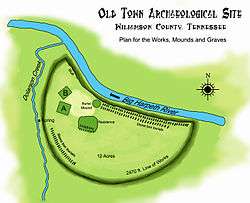 |
Village site along the Natchez Trace on the banks of the Harpeth River in Franklin, Tennessee. Occupancy dated from approximately 900 to 1450 CE. |
| Parkin Archeological State Park | 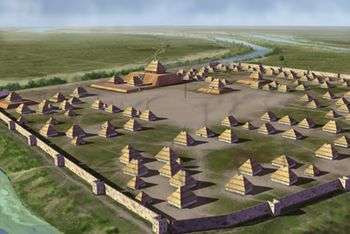 |
The type site for the Late Mississippian Parkin Phase, believed by many archaeologists to be the province of Casqui visited by Hernando de Soto in 1542.[38] |
| Prather Site | 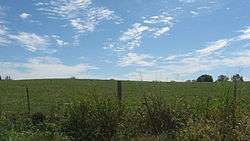 |
Located on a loess-capped upland ridge 4.9 kilometres (3.0 mi) west of the Ohio River and 2.4 kilometres (1.5 mi) east of Silver Creek in the Falls of the Ohio region in Clark County, Indiana. It was the principal ceremonial center of the Prather Complex, the northeastern most regional variant of the Middle Mississippian culture. It also bordered on several Upper Mississippian cultures, including the Fort Ancient peoples of Southern Indiana, Southern Ohio and Northeastern Kentucky.[41] |
| Punk Rock Shelter | A rock shelter found in Putnam County, Georgia and now inundated by Lake Oconee. The only known site producing a large collection of vessels from the Lamar Phase and Savannah Phase in the Oconee Valley.[42] | |
| Rembert Mounds | A South Appalachian Mississippian multi-mound and village site located in Elbert County, Georgia in the area that is now under Lake Strom Thurmond on the Savannah River.[43] | |
| Riverview Mounds Archaeological Site | A Middle Mississippian multi-mound and village site located in Montgomery County, Tennessee just south of Clarksville on the Cumberland River.[44] | |
| Rowlandton Mound Site | 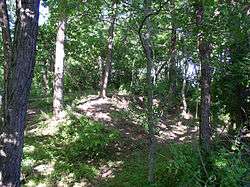 |
Located in Paducah in McCracken County, Kentucky, on the edge of an old oxbow lake a little south of the Ohio River. The site was occupied from about 1100 to about 1350 CE, the 3 hectare site has a large platform mound and an associated village area.[45] |
| Sellars Indian Mound |  |
A single mound site located near Lebanon, Tennessee from about 1000 CE until 1300 CE |
| Shiloh Indian Mounds Site |  |
Shiloh Indian Mounds Site is an archaeological site of the South Appalachian Mississippian culture. Located beside the Tennessee River on the grounds of the Shiloh National Military Park, it was inhabited from around 1000 CE until it was abandoned in approximately 1450 CE.[46] Because it has been included within the national military park for so long it has not been disturbed by modern farming. Remains of the original structures of wattle and daub are still visible as low rings or mounds. It is one of the few places in the eastern U.S. where such remains are visible.[47][48] |
| Sixtoe Mound | A single mound and village site located in Murray County, Georgia and excavated by Arthur Randolph Kelly from 1962-1965 as a part of the Carters Dam project conducted for the National Park Service by the University of Georgia.[49] | |
| Slack Farm | Slack Farm is a site of the Caborn-Welborn culture(a Late Mississippian variant) located near Uniontown, Kentucky close to the confluence of the Ohio River and the Wabash River. The site included a mound and an extensive village occupation dating between 1400-1650 CE. | |
| Spiro Mounds |  |
One of the best-studied archaeological centers of Mississippian culture; a number of significant artifacts were recovered, though looters made off with many of them; located in eastern Oklahoma |
| Sugarloaf Mound | The sole remaining Mississippian platform mound in St. Louis, Missouri. The mound covers three city blocks, measures approximately 40 feet in height, 100 feet north/south and 75 feet east/west. | |
| Summerour Mound Site | A South Appalachian Mississippian single mound and village site located in Forsyth County, Georgia, formerly on a floodplain of the Chattahoochee River in northern Georgia but now submerged under Lake Lanier.[50] | |
| Swallow Bluff Island Mounds | The northernmost outpost of the Shiloh polity, located near Saltillo on an island in the Tennessee River in Hardin County, Tennessee. The site featured two platform mounds, a plaza and a village area.[51] | |
| Travellers Rest (Nashville, Tennessee) |  |
In 1799, the two story structure with four rooms was built by Judge John Overton (1766–1833). Overton originally named the property Golgotha after the large number of prehistoric skulls that were unearthed while digging the cellar of the house. Archaeologists now know that these remains were part of a large Mississippian village site. In 1996 a modern barn structure was built and 13 stone coffins were discovered, also dating back to the Mississippians. Overton changed the name of the plantation to Travellers Rest in the early 19th century to reflect the recreational effect his home had on him after the long rides on horseback that he had to undertake as a circuit judge.[52] |
| Tolu Site | A three mound site near the unincorporated community of Tolu, Crittenden County, Kentucky. It was built and occupied between 1200-1450 CE.[53] Tolu Site is part of the Angel Phase of the Mississippian period. | |
| Towosahgy State Historic Site |  |
A Mississippian chiefdom in southeastern Missouri |
| Town Creek Indian Mound | |
A Mississippian chiefdom in North Carolina, generally attributed to the historic Pee Dee (tribe) |
| Turk Site | located near Bardwell in Carlisle County, Kentucky, on a bluff spur overlooking the Mississippi River floodplain. The 2.5 hectare site was occupied during the Dorena Phase(1100 to 1300 CE) and into the Medley Phase(1300-1500 CE) of the local chronology.[54] Its inhabitants may have moved from the Marshall Site, which is located on the nearest adjacent bluff spur. The layout of the site is characteristically Mississippian, with a number of platform mounds surrounding a plaza.[55][56] | |
| Twin Mounds Site | Also known as the Nolan Site, it is located near Barlow in Ballard County, Kentucky, just north of the confluence of the Ohio and Mississippi Rivers. The site consists of two large platform mounds around a central plaza and a large 2 metres (6.6 ft) thick midden area.[57] | |
| Welborn Village Archeological Site | Also known as the Murphy's Landing Site, this site is an archaeological site of the Caborn-Welborn culture. | |
| Wickliffe mounds |  |
A chiefdom on a bluff top in the far western Kentucky town of Wickliffe |
| Wilbanks Site | A Late South Appalachian Mississippian single mound and village site in Cherokee County, Georgia once located about midway between the towns of Cartersville, Georgia to the west, and Canton, Georgia to the east on the south bank of the Etowah River, but now submerged underneath Lake Allatoona.[58] | |
| Winterville Site | 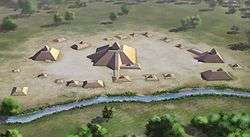 |
The type site for the Winterville phase of the Plaquemine Mississippian culture. |
See also
- Mississippian culture
- Southeastern Ceremonial Complex
- List of sites and peoples visited by the Hernando de Soto Expedition
References
- ↑ http://www.georgiaencyclopedia.org/nge/Article.jsp?id=h-707
- ↑ Lewis, R. Barry (1996). "Chapter 5:Mississippian Farmers". Kentucky Archaeology. University Press of Kentucky. p. 142. ISBN 0-8131-1907-3.
- ↑ Robert L. Stephenson (March 1970). "Adamson Mounds Site" (pdf). National Register of Historic Places - Nomination and Inventory. Retrieved June 2014. Check date values in:
|access-date=(help) - ↑ Harold, Huscher (1972), The Avery Site : Archaeological Investigations in the West Point Dam Area:A Preliminary Report, 1 of 2, Department of Sociology and Anthropology: University of Georgia
- ↑ Kevin E. Smith; James V. Miller (2009). Speaking with the Ancestors-Mississippian Stone Statuary of the Tennessee-Cumberland region. University of Alabama Press. pp. 53–67. ISBN 978-0-8173-5465-7.
- ↑ Anderson, David G. (1996). "Chiefly Cycling and Large-Scale Abandonments as Viewed from the Savannah River Basin". In John F. Scarry. Political Structure and Change in the Prehistoric Southeastern United States. Gainesville: University Press of Florida. pp. 150–191.
- ↑ "Locality information for Faunmap locality Belcher Mound, LA". Retrieved 2010-02-22.
- ↑ "The Caddo Indians of Louisiana". Retrieved 2010-02-22.
- ↑ "Historical-Belcher". Retrieved 2010-02-22.
- ↑ Kelly, Arthur R, Explorations at Bell Field Mound and Village Seasons 1965, 1966, 1967, 1968, University of Georgia Archaeology Laboratory Manuscript
- ↑ "Indian Mounds of Mississippi : Boyd Mounds Site". NPS.GOV.
- ↑ Lankford, George E.; Reilly, F. Kent; Garber, James F. (2011-01-15). Visualizing the Sacred: Cosmic Visions, Regionalism, and the Art of the Mississippian World. University of Texas Press. p. 198. ISBN 978-0-292-72308-5.
- ↑ Barker, Gary; Kuttruff, Carl (Summer 2010). Michael C. Moore, ed. "A Summary of Exploratory and Salvage Archaeological Investigations at the Brick Church Pike Mound Site (40DV39), Davidson County, Tennessee" (PDF). Tennessee Archaeology (Editors Corner). Tennessee Council for Professional Archaeology. 5 (1).
- ↑ Hally, David J. (1998-08-01). "Chauga". In Gibbon, Guy; Kenneth M., Ames. Archaeology of Prehistoric Native America: An Encyclopedia. Routledge. pp. 143–144. ISBN 978-0-8153-0725-9.
- ↑ "Cloverdale Archaeological Site". Retrieved 2009-10-09.
- ↑ "History". State of Illinois. Retrieved 2009-10-21.
- ↑ Smith, Marvin T. (1994). "Archaeological Investigations at the Dyar Site, 9GE5" (PDF). University of Georgia.
- ↑ "National Historic Landmarks Program-Eaker Site". Retrieved 2009-05-31.
- ↑ Parmalee, Paul W. (June 1967). "Additional noteworthy records of birds from archaeological sites" (PDF). The Wilson Bulletin. 79 (2).
- ↑ Griffin, James B.; Morse, Dan F. (1961). "The Short Nosed God from the Emmons Site, Illinois". American Antiquity. Society for American Archaeology. 26 (4): 560. doi:10.2307/278753. JSTOR 278753.
- ↑ Hutt, Sherry. "Notice of Inventory Completion: Tennessee Department of Environment and Conservation, Division of Archaeology, Nashville, Tennessee". Federal Register. Retrieved 2011-04-11.
- ↑ Warwick, Rick (2010). Historical Markers of Williamson County Tennessee, Revised: A Pictoral Guide. Nashville, Tennessee: Panacea Press.
- ↑ "Jaketown Site". National Park Service. Retrieved 2011-04-02.
- ↑ Hudson, Charles M.; Carmen Chaves Tesser (1994). The Forgotten centuries: Indians and Europeans in the American South, 1521-1704. Athens: University of Georgia Press. pp. 379–381. ISBN 978-0-8203-1473-0.
- ↑ Williams, John Mark. The Joe Bell Site: Seventeenth Century Lifeways on the Oconee River. Diss. U of Georgia, 1983
- ↑ Wes Helbling (2009-10-15). "A look at ancient Morehouse". Bastrop Daily Enterprise. Retrieved 2011-10-20.
- ↑ Tristam R. Kidder. "Excavatins at the Jordan Site (16MO1) Morehouse Parish, Louisiana". JSTOR 40712974.
- ↑ Marvin T. Smith (2002-08-07). "Late Prehistoric/Early Historic Chiefdoms (ca. A.D. 1300-1850) : The Nature of Chiefdoms". New Georgia Encyclopedia. University of Georgia and Georgia Humanities Council.
- ↑ Williams, Mark (1999). "Lamar Revisited : 1996 Test Excavations at the Lamar Site" (PDF). Lamar Institute, University of Georgia.
- ↑ Hudson, Charles M. (1997). Knights of Spain, Warriors of the Sun. University of Georgia Press. pp. 157–162.
- ↑ "Office of University Outreach Scholarship Grant Black Belt Environmental Science and Arts Program: 2005 Progress Report" (PDF). Auburn University. Retrieved 2008-10-14.
- ↑ Hally, David; Beverly Cooper; Janet Roth (1978), Archeological Investigation of the Little Egypt Site (9Mu102), Murray County, Georgia, 1969 Season (18), University of Georgia Laboratory of Archaeology Series
- ↑ "Long Swamp site reexamined". The Society for Georgia Archaeology. 2008-10-01. Retrieved 2013-03-04.
- ↑ John H. Blitz; Karl G. Lorenz (April 28, 2006). The Chattahoochee Chiefdoms. University Alabama Press. p. 55. ISBN 978-0-8173-5277-6.
- ↑ Cotter, John L. (July 1952). "The Mangum Plate". American Antiquity. 18 (1): 65. doi:10.2307/276247. JSTOR 276247.
- ↑ Lewis, R. Barry (1996). "Chapter 5:Mississippian Farmers". Kentucky Archaeology. University Press of Kentucky. pp. 128–130. ISBN 0-8131-1907-3.
- ↑ Pollack, David (2008), "Chapter 6:Mississippi Period", in David Pollack, The Archaeology of Kentucky:An update (PDF), Kentucky Heritage Council, pp. 614–615, retrieved 2010-10-29
- 1 2 3 Hudson, Charles M. (1997). Knights of Spain, Warriors of the Sun. University of Georgia Press.
- ↑ "Southeastern Prehistory: Mississippian and Late Prehistoric Period". "National Park Service". Retrieved 2007-12-04.
- ↑ Duncan, Barbara R.; Riggs, Brett H (2003). Cherokee Heritage Trails Guidebook. Chapel Hill: University of North Carolina Press. pp. 152–153. ISBN 0-8078-5457-3.
- ↑ Munson, Cheryl Ann; McCullough, Robert G. "Topographic mapping and transect survey of the Prather Archaeological site (12-CL-4), Clark County, Indiana" (PDF). Indiana University-Bloomington.
- ↑ Williams, Mark. "Archaeological Investigations at the Punk Rock Shelter (9PM211)" (PDF). LAMAR Institute Publication 9. LAMAR Institute. Retrieved 2011-11-27.
- ↑ Caldwell, Joseph R. (1953), The Rembert Mounds, Elbert County, Georgia, Smithsonian Institution: Bureau of American Ethnology 154, pp. 303–20
- ↑ Deter-Wolf, Aaron. "National Register of Historic Places Nomination: RiverView Mounds Archaeological Site (40MT44), Montgomery County Tennessee". Academia.edu. Retrieved 2012-11-22.
- ↑ Kriesa, Paul P. (1998). "Chronology in Western Kentucky". In O'Brien, Michael J.; Dunnell, Robert C. Changing perspectives on the archaeology of the Central Mississippi Valley. University of Alabama Press. ISBN 0-8173-0909-8.
- ↑ Paul D. Welch (2005). Archaeology at Shiloh Indian Mounds, 1899-1999. University of Alabama Press. ISBN 978-0-8173-1481-1.
- ↑ "Shiloh Indian Mounds". Retrieved 2010-06-30.
- ↑ "Shiloh Indian Mounds - National Historic Landmark". Retrieved 2010-06-30.
- ↑ Williams, J. Mark. (1990). Lamar Archaeology : Mississippian Chiefdoms in the Deep South. University of Alabama Press.
- ↑ Thomas J. Pluckhahn (Winter 1996). "Summerour Mound (9FO15) and Woodland Platform Mounds in the Southeastern United States". Southeastern Archaeology. 15 (2): 191–211. JSTOR 40713077.
- ↑ Welch, Paul D. (Summer 2004). Michael C. Moore, ed. "Fieldwork at Swallow Bluff Island Mounds, Tennessee (40HR16) in 2003" (PDF). Tennessee Archaeology. Tennessee Council for Professional Archaeology. 1 (1): 36–48.
- ↑ http://travellersrestplantation.org
- ↑ Kevin E. Smith; James V. Miller (2009). Speaking with the Ancestors-Mississippian Stone Statuary of the Tennessee-Cumberland region. University of Alabama Press. pp. 146–148. ISBN 978-0-8173-5465-7.
- ↑ Lewis, R. Barry (1996). "Chapter 2:The Western Kentucky border and the Cairo lowland". In McNutt, Charles H. Prehistory of the Central Mississippi Valley. University of Alabama Press. pp. 67–70. ISBN 0-8173-0807-5.
- ↑ Lewis, R. Barry (1996). "Chapter 5:Mississippian Farmers". Kentucky Archaeology. University Press of Kentucky. pp. 128–130. ISBN 0-8131-1907-3.
- ↑ Pollack, David (2008), "Chapter 6:Mississippi Period", in David Pollack, The Archaeology of Kentucky:An update (PDF), Kentucky Heritage Council, pp. 614–615, retrieved 2010-10-29
- ↑ Pollack, David (2008), "Chapter 6:Mississippi Period", in David Pollack, The Archaeology of Kentucky:An update (PDF), Kentucky Heritage Council, p. 626, retrieved 2010-10-29
- ↑ Sears, William H. (1958), The Wilbanks Site (9CK-5), Georgia. River Basin Survey Papers 12, Washington D.C.: Bureau of American Ethnology, p. 138
External links
| Wikimedia Commons has media related to Mississippian sites. |
This article is issued from Wikipedia - version of the 11/22/2016. The text is available under the Creative Commons Attribution/Share Alike but additional terms may apply for the media files.

